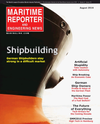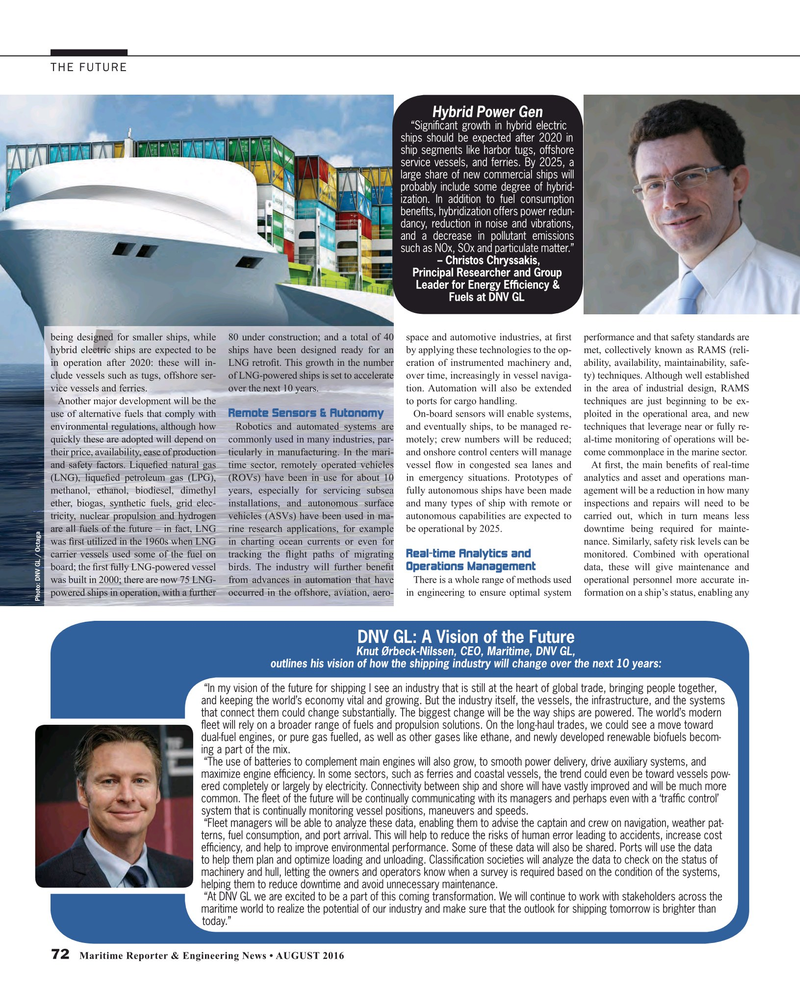
Page 72: of Maritime Reporter Magazine (August 2016)
The Shipyard Edition
Read this page in Pdf, Flash or Html5 edition of August 2016 Maritime Reporter Magazine
THE FUTURE
Hybrid Power Gen “Signi? cant growth in hybrid electric ships should be expected after 2020 in ship segments like harbor tugs, offshore service vessels, and ferries. By 2025, a large share of new commercial ships will probably include some degree of hybrid- ization. In addition to fuel consumption bene? ts, hybridization offers power redun- dancy, reduction in noise and vibrations, and a decrease in pollutant emissions such as NOx, SOx and particulate matter.” – Christos Chryssakis,
Principal Researcher and Group
Leader for Energy Ef? ciency &
Fuels at DNV GL being designed for smaller ships, while 80 under construction; and a total of 40 space and automotive industries, at ? rst performance and that safety standards are hybrid electric ships are expected to be ships have been designed ready for an by applying these technologies to the op- met, collectively known as RAMS (reli- in operation after 2020: these will in- LNG retro? t. This growth in the number eration of instrumented machinery and, ability, availability, maintainability, safe- clude vessels such as tugs, offshore ser- of LNG-powered ships is set to accelerate over time, increasingly in vessel naviga- ty) techniques. Although well established vice vessels and ferries. over the next 10 years. tion. Automation will also be extended in the area of industrial design, RAMS
Another major development will be the to ports for cargo handling. techniques are just beginning to be ex- use of alternative fuels that comply with On-board sensors will enable systems, ploited in the operational area, and new Remote Sensors & Autonomy environmental regulations, although how Robotics and automated systems are and eventually ships, to be managed re- techniques that leverage near or fully re- quickly these are adopted will depend on commonly used in many industries, par- motely; crew numbers will be reduced; al-time monitoring of operations will be- their price, availability, ease of production ticularly in manufacturing. In the mari- and onshore control centers will manage come commonplace in the marine sector.
and safety factors. Lique? ed natural gas time sector, remotely operated vehicles vessel ? ow in congested sea lanes and At ? rst, the main bene? ts of real-time (LNG), lique? ed petroleum gas (LPG), (ROVs) have been in use for about 10 in emergency situations. Prototypes of analytics and asset and operations man- methanol, ethanol, biodiesel, dimethyl years, especially for servicing subsea fully autonomous ships have been made agement will be a reduction in how many ether, biogas, synthetic fuels, grid elec- installations, and autonomous surface and many types of ship with remote or inspections and repairs will need to be tricity, nuclear propulsion and hydrogen vehicles (ASVs) have been used in ma- autonomous capabilities are expected to carried out, which in turn means less are all fuels of the future – in fact, LNG rine research applications, for example be operational by 2025. downtime being required for mainte- was ? rst utilized in the 1960s when LNG in charting ocean currents or even for nance. Similarly, safety risk levels can be carrier vessels used some of the fuel on tracking the ? ight paths of migrating monitored. Combined with operational Real-time Analytics and
Operations Management board; the ? rst fully LNG-powered vessel birds. The industry will further bene? t data, these will give maintenance and was built in 2000; there are now 75 LNG- from advances in automation that have There is a whole range of methods used operational personnel more accurate in- powered ships in operation, with a further occurred in the offshore, aviation, aero- in engineering to ensure optimal system formation on a ship’s status, enabling any
Photo: DNV GL / Octaga
DNV GL: A Vision of the Future
Knut Ørbeck-Nilssen, CEO, Maritime, DNV GL, outlines his vision of how the shipping industry will change over the next 10 years: “In my vision of the future for shipping I see an industry that is still at the heart of global trade, bringing people together, and keeping the world’s economy vital and growing. But the industry itself, the vessels, the infrastructure, and the systems that connect them could change substantially. The biggest change will be the way ships are powered. The world’s modern ? eet will rely on a broader range of fuels and propulsion solutions. On the long-haul trades, we could see a move toward dual-fuel engines, or pure gas fuelled, as well as other gases like ethane, and newly developed renewable biofuels becom- ing a part of the mix.
“The use of batteries to complement main engines will also grow, to smooth power delivery, drive auxiliary systems, and maximize engine ef? ciency. In some sectors, such as ferries and coastal vessels, the trend could even be toward vessels pow- ered completely or largely by electricity. Connectivity between ship and shore will have vastly improved and will be much more common. The ? eet of the future will be continually communicating with its managers and perhaps even with a ‘traf? c control’ system that is continually monitoring vessel positions, maneuvers and speeds.
“Fleet managers will be able to analyze these data, enabling them to advise the captain and crew on navigation, weather pat- terns, fuel consumption, and port arrival. This will help to reduce the risks of human error leading to accidents, increase cost ef? ciency, and help to improve environmental performance. Some of these data will also be shared. Ports will use the data to help them plan and optimize loading and unloading. Classi? cation societies will analyze the data to check on the status of machinery and hull, letting the owners and operators know when a survey is required based on the condition of the systems, helping them to reduce downtime and avoid unnecessary maintenance.
“At DNV GL we are excited to be a part of this coming transformation. We will continue to work with stakeholders across the maritime world to realize the potential of our industry and make sure that the outlook for shipping tomorrow is brighter than today.” 72 Maritime Reporter & Engineering News • AUGUST 2016
MR #8 (66-73).indd 72 8/1/2016 4:00:15 PM

 71
71

 73
73
